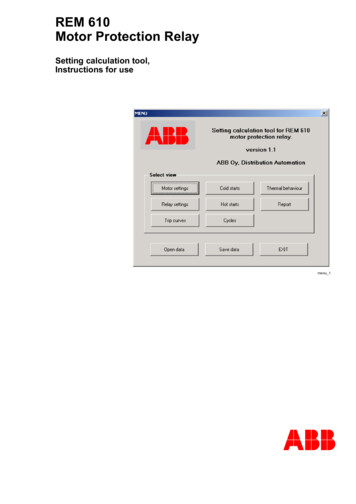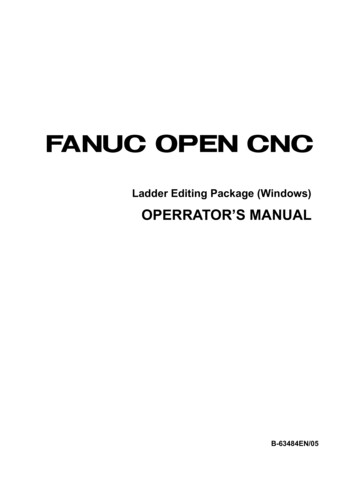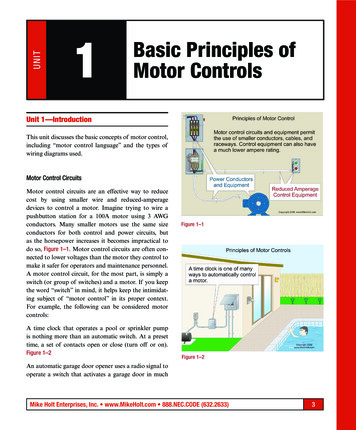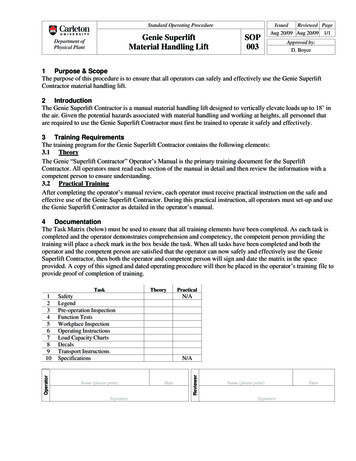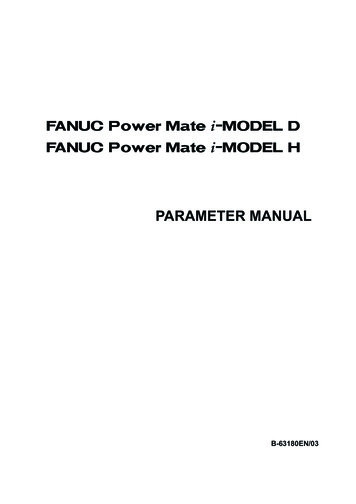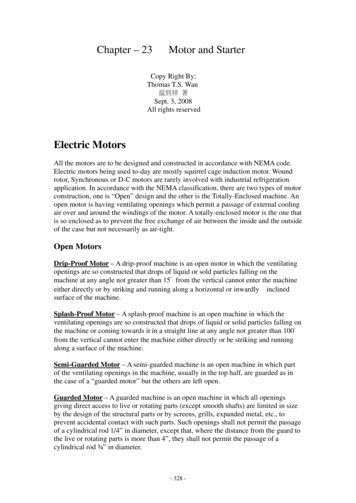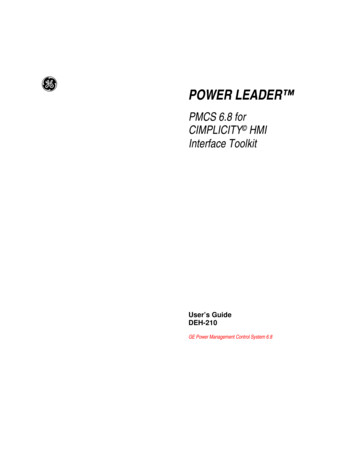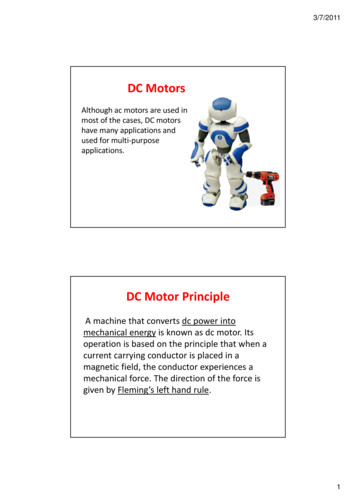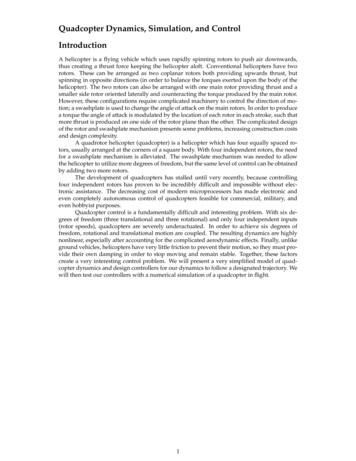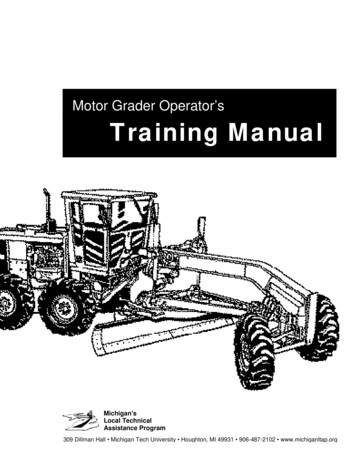
Transcription
Motor Grader Operator’sTraining ManualMichigan'sLocal TechnicalAssistance Program309 Dillman Hall Michigan Tech University Houghton, MI 49931 906-487-2102 www.michiganltap.org
Motor Grader Training ManualTable of ContentsIntroduction . 1Preface and Acknowledgements . 1County Engineers . 2Parts of the Road . 3Parts of a Road . 3Proper Cross-Section . 4Roadway Cross-Section Elements . 5Typical Section for a Local Road (English) . 6Typical Section for a Local Road (Metric) . 7Gravel . 8Five Factors . 9Dust Control . 10On the Road . 10Fighting Potholes and Dust . 12Calcium Chloride – Environmental Concerns . 14Environmental Facts About Calcium Chloride . 16Dust Blading . 19Erosion Control. 20Why Is Everyone So Concerned? . 20Six Major Principles . 21Drainage . 22Culvert Maintenance . 23Road Graders . 24Grader Types . 25Grader Operation . 26Tips for Better Grading . 28Daily Inspection Check . 29Pre-Start Walk-Around Inspection . 30Walk-Around Inspection (Diagram) . 34Walk-Around Inspection (Checklist) . 35Grader Preventive Maintenance . 36Preventive Maintenance Checklist . 38Radiator-Cooling System . 39Tire Maintenance . 39Safety Procedures . 41Comprehensive Checklist. 41Safety Tips and Safe Operation . 43Maintaining Gravel Roads . 44Introduction . 44Two Common Mistakes . 46Slope Meters . 47Tires. 48Carbide Bit Blades . 49Washboards . 51Eliminating Berm . 52Figuring the Cost . 53How to Figure the Cost of Lost Gravel . 53Two Closing Thoughts . 54i
Preface and AcknowledgementsThis notebook was prepared for use in workshops being presented at various locations throughoutMichigan as part of a program developed by the Michigan Local Technical Assistance Program(LTAP). Materials in this notebook have been adapted from material generously provided by theNebraska Technology Transfer Center, and the Maine Local Roads Center.The workshops are intended for county, city, and township employees who are responsible formaintaining gravel roads and require a working knowledge of gravel road characteristics, basicmaintenance procedures, and grader operator skills.Workshop InstructorJeffrey Shook, Genesee CRC retiredDisclaimerThe contents of this notebook do not necessarily reflect any official views or policies, and use orreference to specific products or equipment does not imply endorsement of these products by anyuniversity, local, state, or federal agencies. This notebook does not constitute a standard,specification, or regulation.1
Motor Grader Rated #1 – Most Useful and VersatileCounty EngineersWhat do you call a county engineer with a motor grader? A highway department. This is an old joke, but it’strue; the versatile motor grader was the number one choice among the 10 most important pieces of equipmentused by county highway departments, according to results of a survey conducted by Better Roads’ editors.Nearly 88% of the surveyed county engineers and equipment operations managers called the grader their mostimportant piece of equipment. Trucks were not far behind.The county highway department equipment top 10, as chosen by those who specify and buy the machines are:1.2.3.4.5.6.7.8.9.10.Motor grader.Dump truck.Pickup truck.A tie between mowers and surveying equipment.A tie between snowplow and loader.Spreader/salter.Water truck.A tie between excavators and portable barricades.Bulldozer.Pothole patcher.Maintaining RoadsBannock County, Idaho engineer Terry Bailey chose the motor grader as his top equipment pick, explaining, “Wemaintain 250-plus miles of gravel roads and do snow removal. This equipment does duty all seasons.”While often the motor grader is converted for winter road maintenance in more northerly areas, Gary Adkins,county engineer in Lexington, South Carolina, also chose the motor grader, explaining, “We grade over 800miles of unpaved road. We grade daily, weather permitting, with the bulk of our road maintenance activity motorgrading.”Adkins says his department has 20 motor graders in its road fleet, with Caterpillar being the mainstay of thedepartment, although other manufacturers’ equipment – John Deer, Champion, and Galion – are also listed in hisinventory. Brian Faust in Fulton, Missouri, explains that motor graders are the only way to maintain the roads inhis county. “We have 800 miles of gravel roads,” Faust explains, and his stable of 10 graders – a Cat 135H, 8John Deere 670 Bs, and a Fiat F675 – does the bulk of the work keeping roads in shape.North Dakota engineer Jon Mill sys, “Roadway maintenance is a large part of our assignment, and the motorgrader addresses many maintenance functions. It offers versatility, can blade gravel, lay patching mix, plowsnow, mix material, and do finish grade work.”Road construction was the main reason listed by Donald Brandon, Chambers County, Texas HighwayDepartment engineer, for his choice of motor grader as the number one piece of equipment. Construction andmaintenance of some 150 miles of gravel roads prompted Brandon to list compactor and dump truck as numberstwo and three, respectively, to go along with the grader to meet his construction needs.Overall, 33% of those responding to the survey picked the motor grader as their first equipment choice.“County Engineers.” Better Roads (July 1997) : 16.2
Parts of a RoadA road is composed of three major elements (see Figure 1): The surfaceThe base and/or subbase layer(s)The subgradeThe surface or ‘wearing surface’ may be asphalt, concrete, gravel, or other material. It must providea good riding surface as well as wear resistance, skid resistance, and waterproofing.The base and/or subbase layers provide the strength to carry heavy loads and support for thepavement surface. This material consists of compacted gravel, sand, crushed rock, or a combinationof these. A minimum compacted thickness should be 18 inches for local roads.The third element is the subgrade. This could be fill material if an embankment is being built to aheight more than 2 to 3 feet high, or it could be the existing natural soil in cut sections. It is thesubgrade which ultimately carries the traffic loads.Before construction of a road, the top 12 to 24 inches of existing ground is usually prepared byremoving large boulders, stumps, bushes, and other objectionable materials.The main function of the pavement surface and the subbase materials is to support a wheel load andto spread and transfer that load to the subgrade. The ultimate load on the natural subgrade surfaceshould be small enough to be easily supported by the subgrade.3
Proper Cross-SectionTo maintain good drainage, a road needs proper cross-section:(Figure 1)Without proper drainage, no roadway can survive. With proper drainage, you can maintain a stablebase and keep a proper cross-section. And with a proper cross-section, the roadway, shoulder,inslope, ditch, and backslope will drain properly and your roads will be in better condition and easierto maintain under all weather conditions. Practice good maintenance habits and your time will be wellspent.Overall, this information will help you better understand your role as a gravel road maintainer andsharpen your skills so that you can do the best job possible in maintaining your local gravel roadsystem!4
Roadway Cross-Section ElementsOther cross-section elements of a typical road are also illustrated in Figure 1. The road surfaceshould be crowned or sloped so that water will drain to the left and right towards the ditch. The slopeshould be ¼ inch per foot of paved road width and ½ to ¾ inch per foot of gravel road width.PavedGravel¼ “ perfoot½ “ perfootPotholes in gravel surface roads can be directly related to road crown. Those roads with nocrown will experience the most severe pothole problems, and those with a cross slope of ½ inch perfoot or more should have very few pothole maintenance problems.As you maintain your roads, you should be aware of what the town’s standard dimensions are fordifferent types of roads. If a road does not meet the standard, you can gradually bring it back tostandard as you work on it. If it gets completely out of hand, an expensive re-grading or rebuildingjob might be necessary. Not only that, but there are potential legal problems that can develop if roadsstandards are neglected and a serious accident results.(Figure 2)5
6
7
8
Five Factors Which Affect a Road’s LifeMoistureThis can enter a road from surface cracks,the underlying water table, and thesurrounding soil. The effects of water canbe devastating, especially in Maine, whenwater freezes and heaves the roads eachwinter and spring.TrafficRoad damage depends on the number ofvehicles using the road, but even more onthe weight of vehicles. A few heavilyloaded wheels do far more damage thanmany light ones. For example, it takes500,000 axles carrying one ton each(passenger car) to produce the samedamage as eleven axles carrying 16 tonseach.SubgradeSince the road depends on the naturalground for support, the quality of thesurface can create large differences inpavement performance.ConstructionQualityFactors such as the moisture conditionduring construction, the lack of proper soilcompaction, and the quality of pavingmaterials can seriously affect roadperformance.Maintenance.The life of a road depends on what, when,and how maintenance is performed.9
On the RoadThe Newsletter for State Highway SuperintendentsSpring 1992Liquid Calcium Chloride Keeps Roads in Houlton, Maine “Golden”Ralph Cleale, public works superintendent for Houlton, Maine,might never have tried liquid calcium chloride to control dust onhis town’s unpaved roads had it not been for the “Golden Road.”The town of Houlton sits on the border with New Brunswick,Canada, close to Maine’s prime timber territory. Most everyone inthe state is familiar with the central logging truck artery called the“Golden Road,” which links an impressive network of unpavedroads built by local paper mills in the mid-1970s. With a great dealof money invested in their roads, the paper companies tried newmethods and materials to build and maintain them, including liquidcalcium chloride.Traffic on the roads is not limited just to trucks. Mr. Clealetraveled some of them on trips to his hunting camp and noticed alack of dust and their overall good condition in spite of the heavytruck traffic. Curiosity led him to investigate how the roads stayedin such good shape. He learned that liquid calcium chloride was akey part of the maintenance strategy. Since he had also heardabout the material through magazine articles and advertisements, he was eager to try it.“Complaints from Houlton residents about the dust from town roads in dry months were constant,” says Mr.Cleale. “We’d found no reliable way to control the dust.”In 1988, he tested liquid calcium chloride on about one mile of a particularly rutted and dusty roadway, spreading4,000 gallons. The results were as expected. “The calcium chloride performed just as the advertisements said itwould,” says Mr. Cleale. “Over the next two years, we tripled the amount applied. It not only totally eliminatedthe complaints and reduced the loss of fines, it also kept the roads compact. They stay together so well thatwe’ve reduced grading by 70 percent.”With less grading, Mr. Cleale finds he is able to devote much less effort to maintaining the roads. He uses themanpower that had been assigned to grading his formerly dusty roads in other important summer maintenancetasks.The town’s road crew developed a regular procedure in laying the solution down. The roads are first lightlygraded to loosen their surfaces, with the crew occasionally adding gravel to fill in low areas.“Prepping the roads is a bit of a juggling act,” says Mr. Cleale. “We finish grading just before we order the spraytruck to apply the material. We’ve learned to time this just right so traffic and rain won’t compact the surfaces.”Loosening the surface allows liquid calcium chloride to penetrate better, improving the ability of the fines andaggregates to bind together. This binding action stabilizes the unpaved road, keeping it dense and compact.After the roads are prepared, W.H. Shurtleff, Inc., South Portland, Maine, is called in. Using a distributor truckwith a rear-mounted spray bar, a 35 percent liquid calcium chloride solution is applied. The truck makes twoeight-foot passes on the 18-to2-foot-wide roads, spraying approximately 2,800 gallons per mile. The liquidcalcium chloride is manufactured by General Chemical Corporation, Parsippany, New Jersey.10
Mr. Cleale concentrates his annual treatment on high traffic areas and in front of houses, spreading a total of12,000 gallons. To ensure that the calcium chloride solution is efficiently applied, he recommends using adistance measuring device to accurately calculate the application rate.“It’s important not only to control how much is applied, but to target where to apply it,” Mr. Cleale explains.“Applicators don’t know our roads, so we guide the truck driver to the correct spots. This way, we’re assured thatwe have treated the intended sections and have obtained optimum coverage.”Through Mr. Cleale’s observation of the “Golden Road,” applying liquid calcium chloride to Houlton’s unpavedroads is now the golden rule.“Liquid Calcium Chloride Keeps Roads inHoulton, Maine ‘Golden’.“ On the Road(Spring 1992)11
Fighting Pot Holes and DustBy Jim L. Hennen, SD LTAP Western Satellite CoordinatorMany communities in South Dakota have anumber of gravel surfaced streets and arefighting an ongoing battle against potholes anddust. Faced with this problem on Canal Streetin the city of Custer, Street Supervisor, CorbinHerman, contracted Alan Sarver of Z&S DustControl, Inc. of Rapid City for some help. Thetwo men decided to treat a five-block sectionof Canal Street with a proprietary product fromPennzoil being marketed under the brandname PennzSuppress D.*It was felt that this would provide a goodopportunity to evaluate the effectiveness of theproduct as a soil stabilizer as well as a dustsuppressant. The treatment was applied inmid-July of this year and the street conditionwas observed approximately three and a halfmonths later.The operation involved blading the entirelength of the section as well as a short sectioncoming onto Canal Street from the north. Thisshort section was to receive the same bladingand rolling passes as the longer five-blocksection but without any of the product beingplaced on it.This provided a goodcomparison between a treated and untreatedsection over which the same traffic volumeand traffic type would be passing.The untreated section pictured at the top hasdeveloped potholes. The treated section in the bottompicture shows no sign of potholes and is in muchbetter condition.After blading, the product was shot at a rate of one quarter gallon per square yard, using the samedistributor as normally used to apply magnesium chloride dust suppressant. Forty-five minutes later asecond application was shot. Following the forty-five minute waiting period for this second applicationto absorb into the surface, a self-propelled rubber tire roller was used to compact the treated surface.Corbin indicated that when they rolled the surfaces (treated and untreated), the treated surfaceglazed up very nicely. When the product was first applied there were thousands of tiny bubbles risingto the surface as the material penetrated the surface. With the second application the bubbles werestill evident but with less activity than with the first shot. Due to limited funds, Corbin elected not toapply the recommended third application before rolling. The two applications, twenty-four feet wideover the five blocks, cost approximately 1650 for the product alone.The effectiveness of the product as a stabilizer for the gravel surfacing was very good and Corbinindicated he was very pleased at how well the five blocks have remained very tight with no potholes12
showing up in the entire length. The short, untreated section has numerous potholes. The differencein the surface conditions between the sections can be seen in the accompanying photographs.The effectiveness with respect to dust control was not what had been hoped for. Both Corbin andAlan indicated that had the third application been given, as the manufacturer recommends, itseffectiveness as a dust suppressant would have received a more favorable evaluation.Z&S Dust Control, Inc. did return to the job site some time later and shot an application of magnesiumchloride to mitigate the dust problem that the treatment did not adequately provide.* The use of product brand names in this newsletterarticle does not constitute any endorsement ofthose products by the SD LTAP Center.Hennen, Jim L.“Fighting Potholes and Dust.”The Connection p. 6.13
Calcium Chloride for Dust ControlAre There Environmental Concerns?A popular method of controlling dust on many of Michigan’s gravel roads is by using calcium chloride.It is available through several different suppliers in the state, in either flake, pellet, or liquid form.Typically, a road will be treated one to three times per year to help keep the surface hard-packed anddust-free under traffic.A common concern around Michigan is whether this ‘salt’ can create a significant environmentalhazard to groundwater, nearby wells, lakes, or vegetation. In one sentence, studies have found thatbecause the amount of calcium chloride required for dust control and stabilization is relatively smalland it is applied relatively infrequently, little potential for significant damage exists. This is unlikesodium chloride (winter road salt) which is used in relatively large quantities for de-icing Michiganroads.The Center has two studies available which discuss this subject.Here are the highlights from each study:“An Environmental Review of Calcium Chloride in Road Dust Control and StabilizationApplications.” Dow Chemical Company (June 1981).I.The widespread use of calcium chloride for dust control and stabilization of unpaved roadsprovides economic, personal safety and environmental benefits while presenting littlepotential for harm to the environment. The evidence to support this conclusion can besummarized as follows:II. The amount of calcium chloride applied for dust control and stabilization is relativelysmall. Only a small percentage of the calcium chloride applied for dust control and stabilizationmoves from the roadway to roadside areas. Little potential exists for damage to roadside vegetation due to lack of calcium chloridemovement and the minor effect of calcium chloride on soils and vegetation. The potential for damage to animal life is small due to the lack of movement fromapplication areas and the low toxicity of calcium chloride. Because migration is limited, surface water contamination is unlikely. Ground water contamination from leaching is unlikely, except in unusual cases.School of Public Health. An Evaluation of Dust Suppressants: Calcium Chloride andLiginsulfonates University of Minnesota (June, 1982).Calcium is present in nearly all waters and is more abundant than any of the other alkalineearth metals. The addition of calcium for dust suppressant most likely would be insignificantwhen compared to the amount already present in the environment.14
The use of calcium chloride as a dust suppressant will elicit the same types of environmentalproblems (chloride pollution of water systems) as it does when used as a road de-icer.However, because these effects are directly related to the rate and method of application ofthe salt, the environmental effects following its use as a dust suppressant should beconsiderably less that those observed from its use as a road de-icer.Due to its low systemic toxicity from oral administration, calcium chloride use as a dustsuppressant poses little internal hazard in animals and humans.Toxicity to vegetation, especially in and around the area of application, should be expectedfrom the use of calcium chloride. This toxicity may be in the form of direct effects on the plantlife or they may arise indirectly via soil disturbances (alkalinity, low water availability, lowsodium availability, and poor aeration).15
EnvironmentalFactsAbout Calcium ChlorideGrowing concern for the environment means that we need to closely examine the materials used in de-icing andother road maintenance. Calcium chloride works well not only for de-icing but also for dust control/basestabilization and full depth reclamation, says Bill Massa of General Chemical Corporation. As its acceptance hasgrown, so have questions about how this substance works and how it impacts water quality and vegetation. Thisarticle answers questions road officials most frequently ask about calcium chloride.How does calcium chloride work when mixed with aggregate?Clays and other soft particles have a large negative surface charge. They act like magnets and repel each other.When water coats the particles, Massa says, it insulates them and reduces the force pushing them apart. Wateralso has a natural surface tension that acts to bind particles together.A dry road is less cohesive than a wet one and loses fines more readily under the pounding of passing cars andtrucks. A commonly used rule of thumb is that one car traveling over a mile of untreated dirt road will throw off aton of gravel per year. Roads that retain water last longer. Calcium chloride helps keep water in roads in twoways.First, as calcium chloride penetrates a road surface, it reduces the negative charge on the particles. Thisdecreases the repelling force between particles and the thickness of the water coating. A thinner coating allowsparticles to move closer together.And second, the surface tension of a calcium chloride solution is far greater than that of plain water. The highersurface tension and the thinner film coating the particles substantially increase the attraction between soilparticles. As the binding ability of the road fines increase, so does road stability. Calcium chloride in reclaimedaggregate and base soils produces a material well suited for use as a road base or wearable surface for anunpaved road.Does calcium chloride migrate once it is added to soil?Calcium chloride tends to stay where it is placed. Studies indicate that calcium chloride migration is minimal andthat total migration is low. Samples from a road in Maine found that the majority of calcium chloride per squareyard remained in the road base after 24 years. A recent study in Ontario, Canada, conducted by TrowGeotechnical Ltd., indicated excellent migration of calcium chloride. Ninety-two percent of the material waspresent 8 months after application.What type of calcium chloride migration is most likely to occur?Most migration occurs vertically in soil, depending upon rainfall, evaporation, temperature, and humidity. As rainsoaks into soil, it carries calcium chloride downward. Evaporation of water from the road surface has theopposite effect due to capillary action. Although calcium chloride rises and falls with weather conditions, little islost from the road. Calcium chloride generally stays in place in road stabilization and dust control work.One study showed that higher water tables carried calcium chloride from the road. With this in mind, calciumchloride should not be placed in roads where drainage is poor.How large a contribution are de-icers to water pollution?A study on dust suppressants prepared for the Environment Ontario Waste Management Branch of the municipalgovernment of Toronto found no adverse effects on water or plants from the use of calcium chloride as a dustsuppressant, Massa says. The effect of salt on ground water is believed to be minimal, but difficult to assessbecause of the many sources of chlorides.More than 4 million tons of salt, both sodium chloride and calcium chloride, are carried in rain and snow eachyear. Sewage treatment and industry also contribute to chloride levels.16
What effect does calcium chloride have on a reservoir?Studies in Maine and Wisconsin by the Highway Research Board in Washington, D.C., examined the effect ofde-icing chemicals on highways. These confirmed that chloride concentrations in rivers and streams are wellwithin acceptable limits, Massa says. The great water volume they contain dilutes chloride concentration toacceptable levels. Many states have instituted reduced salt zones in the vicinity of reservoirs. Calcium chlorideis frequently used in these areas due to its performance and tendency not to migrate.Water pollution from de-icers is primarily limited to shallow wells near roads and small ponds and streams thatget direct runoff from roadways. A study conducted in Maine found chloride concentration related directly todistance from a road.What about calcium chloride in drinking water?The American Medical Association rate for sodium chloride in drinking water is 250 mg/liter. The limit for calciumchloride is the same. It is interesting to note that the 250 mg level was set by the Public Health Service based onthe taste rather than health.Is chloride harmful in drinking water?Humans have drunk water containing as much as 2000 mg of chloride without adverse effects, Massa says.People can taste sodium chloride and calci
Other cross-section elements of a typical road are also illustrated in Figure 1. The road surface should be crowned or sloped so that water will drain to the left and right towards the ditch. The slope should be ¼ inch per foot of paved road width and ½ to ¾ inch per foot of gravel road width. Paved Gravel ¼ " per foot ½ " per foot
